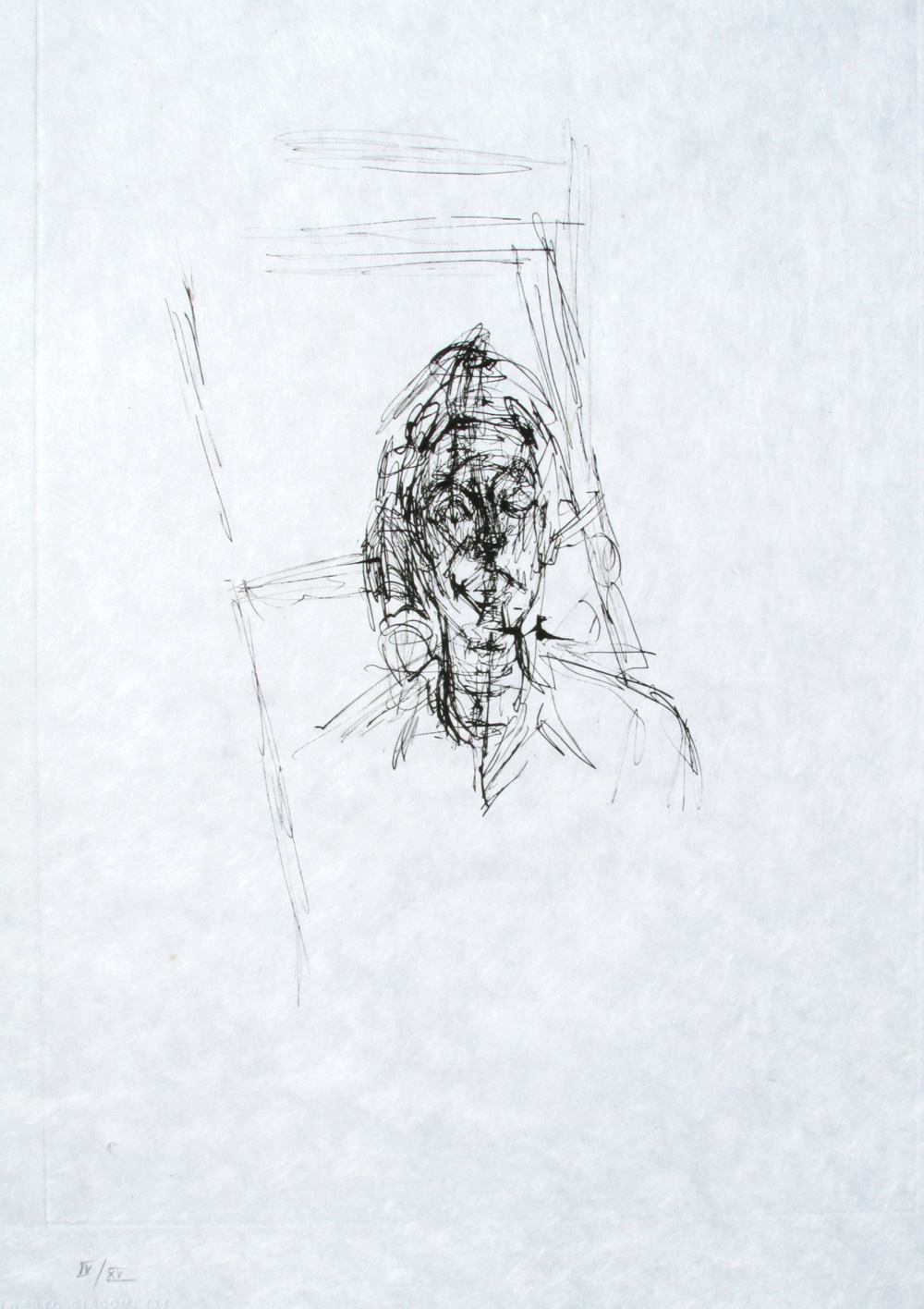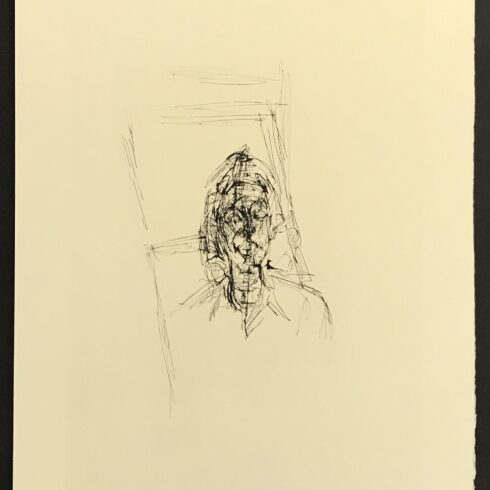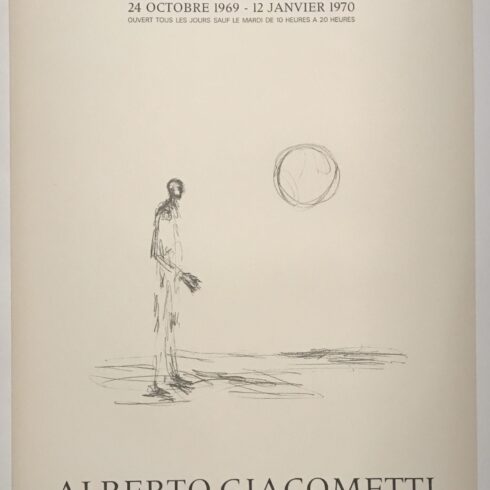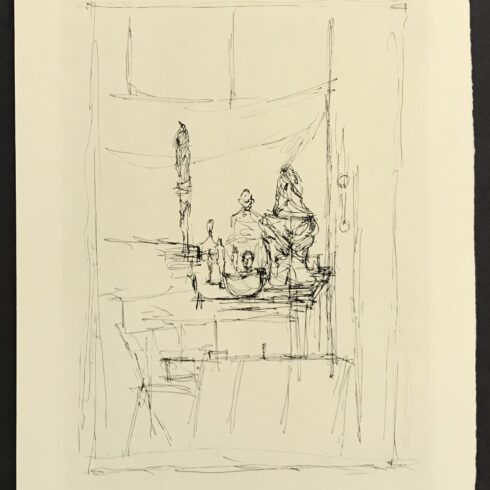La Magie Quotidienne (Face)
La Magie Quotidienne (Face), 1968 by Alberto Giacometti is an etching on Japon paper. This print is from the limited edition of 15 with the blindstamped of the Giacometti estate (the portfolio published after Giacometti’s death). This print was Created for the portfolio ‘La Magie Quotidienne’ released in 1968 including 9 original prints by artists: Arp, Braque, Giacometti, Masson, Miro, Villon, Zao Wou-ki, and Picasso.
Giacometti continued to question his artistic path and search for ways to challenge—or equal—reality in sculpture as well as in painting. For him an artwork was to become an almost magical evocation of reality in an imaginary space, as in heads of Diego and figures after his wife Annette (1952–58), executed like apparitions as both paintings and sculptures. His portraits of Caroline or Elie Lotar, his models and friends in the last years (1958–65), are heads and busts gazing intently and made only with lines of force, without contour lines or surfaces. At that point he felt that reality was no longer dependent on being perceived by someone; reality simply was. Like the characters in Samuel Beckett’s novels and plays, Giacometti’s figures represented an isolated, highly individualistic worldview. In 1961 Beckett, his longtime friend and confidant, asked Giacometti to design a set for his absurdist drama Waiting for Godot (published 1953). The final design consisted of a single plaster tree.
| Medium | Etching |
|---|---|
| Year | 1968 |
| Edition | 15 |
| Catalogue Raisonné | NA |
| Signature | Estate Stamped |
| Size | 20 x 14.25 (in) 51 x 36.25 (cm) |
| Price | SOLD |
Description
La Magie Quotidienne (Face), 1968 by Alberto Giacometti is an etching on Japon paper. This print is from the limited edition of 15 with the blindstamped of the Giacometti estate (the portfolio published after Giacometti’s death). This print was Created for the portfolio ‘La Magie Quotidienne’ released in 1968 including 9 original prints by artists: Arp, Braque, Giacometti, Masson, Miro, Villon, Zao Wou-ki, and Picasso.
Giacometti continued to question his artistic path and search for ways to challenge—or equal—reality in sculpture as well as in painting. For him an artwork was to become an almost magical evocation of reality in an imaginary space, as in heads of Diego and figures after his wife Annette (1952–58), executed like apparitions as both paintings and sculptures. His portraits of Caroline or Elie Lotar, his models and friends in the last years (1958–65), are heads and busts gazing intently and made only with lines of force, without contour lines or surfaces. At that point he felt that reality was no longer dependent on being perceived by someone; reality simply was. Like the characters in Samuel Beckett’s novels and plays, Giacometti’s figures represented an isolated, highly individualistic worldview. In 1961 Beckett, his longtime friend and confidant, asked Giacometti to design a set for his absurdist drama Waiting for Godot (published 1953). The final design consisted of a single plaster tree.
Giacometti was one of the most important sculptors of the 20th century. His work was particularly influenced by artistic styles such as Cubism and Surrealism. Philosophical questions about the human condition, as well as existential and phenomenological debates played a significant role in his work. Around 1935 he gave up on his Surrealistic influences in order to pursue a more deepened analysis of figurative compositions. Giacometti wrote texts for periodicals and exhibition catalogues and recorded his thoughts and memories in notebooks and diaries. His self-critical nature led to great doubts about his work and his ability to do justice to his own artistic ideas but acted as a great motivating force.
Alberto Giacometti is best known for his elongated, withered representations of the human form, including his 1960 sculpture Walking Man I, which in 2010 broke the record for a work of art at auction at $104.3 million. After experimenting with Cubism and Surrealism in forms influenced by primitive art, psychoanalytic theory, and toys, Giacometti broke from Surrealism and began his radical revision of the representational tradition in sculpture. Giacometti’s severe figures explored the psyche and the charged space occupied by a single person. Linked to Jean-Paul Sartre and existentialism, they are seen as metaphors for the postwar experience of doubt and alienation.
Additional information
| Medium | Etching |
|---|---|
| Year | 1968 |
| Edition | 15 |
| Catalogue Raisonné | NA |
| Signature | Estate Stamped |
| Size | 20 x 14.25 (in) 51 x 36.25 (cm) |
| Price | SOLD |





